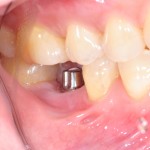
Good survival rates have been demonstrated in a number of studies and implant placement is increasingly common. Immediate placement of implants into extraction socket has also become an established technique. As teeth requiring extraction often have associated pathology there is some controversy over immediate implant placement into infected socket.
The aim of this review was to assess whether the immediate placement of implants in an infected site poses more risk than placement in a health site.
Methods
Searches were conducted in the PubMed, ISI Web of Knowledge, and Cochrane Library databases. Clinical studies involving immediate implant placement into infected sites in the aesthetic zone having a non-infected control group and a follow up period of at least a year were considered. Only English language publications were included.
2 reviewers selected studies abstracted data and assessed study quality using the Newcastle-Ottawa Scale. The implant survival rate was expressed as risk ratio, whereas bone level changes and gingiva level changes were expressed as mean differences in millimetres with 95% confidence intervals.
Results
- 9 studies involving a total of 1735 patients (758 infected, 977 non-infected) were included
- All 9 studies were considered to be of moderate to good quality.
- Follow up periods ranged from 12-60 months.
- The survival rate in infected sites (97.6%) was similar to health sites (98.4%).
- Meta-analysis suggests no statistically significant difference in failure rates between infected and non-infected sockets, RR = 1.68 (95%CI; 0.87 to 3.26).
- No statistically significant differences in bone level changes was seen between the two groups at any time point, MD = 0.03 (95% CI; −0.09 to 0.14).
- Similarly, there were no significant differences in gingival levels, MD = −0.06 (95%CI; −0.13 to 0.01).
Conclusions
The authors concluded: –
Meta-analysis showed that immediate implant placement into infected sites and noninfected sites in aesthetic zone had similar survival rates, bone level changes, and gingiva level changes.
Comments
3 major databases were searched for this review although limiting the inclusion criteria to publication in English may have excluded relevant studies. All the included studies were observational although there is no indication as to whether the studies are pro- or retrospective. While all the included studies had at least one year of follow up no indication is given of loss to follow up in the individual studies and how this was handled in the analysis.
This new review includes 9 studies compared with 7 in an earlier review of this question (Dental Elf – 19th Feb 2016). All 7 of the studies included in the previous review are included in this new review. The findings of the earlier review suggested that there may be an increased risk of failure in infected sockets while this update suggests no difference. However, the quality of the available evidence to support these findings is low to very low.
Links
Primary Paper
Chen H, Zhang G, Weigl P, Gu X. Immediate placement of dental implants into infected versus noninfected sites in the aesthetic zone: A systematic review and meta-analysis. J Prosthet Dent. 2018 Nov;120(5):658-667. doi:10.1016/j.prosdent.2017.12.008. Epub 2018 Jun 28. Review. PubMed PMID: 29961634.
Other references
Dental Elf – 2nd Aug 2017
Dental Elf – 19th Feb 2016
Dental implants – immediate placement in infected sockets may increase failure rates
